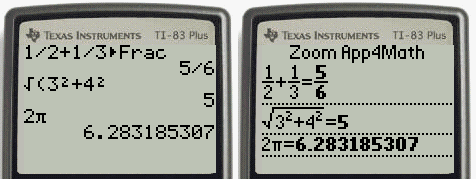

The "-2" is shown in red, indicating the changed parts of the equation.

Choosing that operation yields the next line of the solution: We see the operation we want, Subtract ? from both sides. In the menu, the question mark stands for the selected expression. So we use the mouse to select the 2, just as you would select some text in a word processor:Īs soon as you release the mouse button you will see a popup menu of operations that can be carried out with or to the selected expression: We want to subtract 2 from both sides of the equation.
#ZOOM MATH 500 SHOWING STEPS INTEGRALS HOW TO#
Ignoring the buttons for now, and supposing that we know how to work this problem on paper, let us see how to use MathXpert. After entering the problem (or selecting it from the problems that come with MathXpert), the user reaches the working screen, and sees this: The student is learning how to solve simple linear equations such as 3 x + 2 = 11. Let us begin by pretending it is the first day of algebra class. I will give two examples of the use of MathXpert, one from beginning algebra, and one from second-semester calculus, showing how this works out in practice.Ģ.1. Indeed, this principle combines with the idea that the user should be in control to dictate the basic design of MathXpert: the user chooses the steps and thus controls the development of the computation, while the computer carries out the low-level details. The first and most important design principle of MathXpert is the "glass box" or "transparency" principle-show all the steps. Transparency: MathXpert shows all the steps (I do not believe that it is even desirable to replace teachers and books by computers-see the section on societal implications later in the paper.)Ģ. MathXpert is meant to replace blackboards and homework (and graphing calculators), but not teachers and books. You may, of course, have to ask your teacher why it isn't there. If you have in mind to use this incorrect rule, you will learn something from its unavailability. You will not be able to apply this incorrect rule in MathXpert, because only correct rules are offered as menu choices for you to choose. For example, suppose you think (incorrectly) that ln( x+y) = ln x + ln y. MathXpert is designed to provide a self-correcting way to learn mathematics. This leads to frustration and, if it is often repeated, to a feeling of failure and so-called "math phobia". Worse, they may not be able to find their own mistake. Often, students make a mistake at the third line of a solution, but are unaware of it, and expend a lot of time and energy on work which is completely useless. Worse, there may be no error correction at all. But in the usual means of teaching algebra and calculus, appeal to authority is the usual way in which students verify the correctness of their work-for example, by checking the answer in the back of the book. She designed many physical materials for young children with this principle in mind. That means that the student should be able to discern, by the design of the exercise itself, when the work has been correctly completed, without appeal to authority. Maria Montessori, the Italian educator, introduced the idea that educational materials ought to be You must master each part of the subject before moving on to the next part. You have to be very careful in mathematics, because a slight error can throw you completely off track.These features of MathXpert should be compared to the two main difficulties that people experience in their attempts to learn mathematics: (2) If you do not know what to do, MathXpert can help you. (1) It is not possible to make a mistake. MathXpert is a system that allows a person to do mathematics on a computer screen in much the same way as it is done with pencil and paper, but with some important differences:

KEY WORDS: mathematics education, computer algebra, calculus 1. The paper concludes with a discussion of the current and future use of technology in general, and MathXpert in particular, in mathematics education. The design of MathXpert follows principles dictated by its intended use to support learning these principles and how they influenced MathXpert are discussed. It is capable of generating complete, step-by-step solutions to mathematical problems, but normally this capability is used to assist the student in developing his or her own step-by-step solution. Its scope extends from elementary algebraic manipulations to the most complicated limits and integrals usually considered in University classes. San Jose, California MathXpert is a computer program designed to help students learn algebra, trigonometry, and one-variable calculus. MathXpert: Learning Mathematics in the 21 st Centuryĭepartment of Mathematics and Computer Science "MathXpert: Learning Mathematics in the 21st Century


 0 kommentar(er)
0 kommentar(er)
